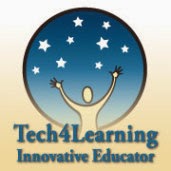"It's not hard, it's just uncomfortable."
Ilisa Cappell said this to me this morning as we were discussing the future of edJEWcon and raising the bar on professional development. She was referring to the mind shift involved in being an information-age educator.
It's so true!
My colleague Karin Hallett has this quote as her email signature:
I am always doing that which I can not do, in order that I may learn how to do it. (attributed to Vincent Van Gogh)
This, to me, is the essence of what it means to "learn, reflect, share."
This is what it means to be a lead learner.
This is what is means to be a teacher.
When Ilisa said that to me, I immediately thought of my upcoming (in about an hour) Mystery Skype session with one of my classes. I planned it on the spur of the moment, and I didn't feel I had properly prepared the students. I knew it could go well or...not so well. I also know that it doesn't have to go "well" (or what I perceive as success) in order for it to qualify as learning.
I am always doing that which I can not do. I am reasonably comfortable working on the edge of my comfort zone. I may not have prepared the students as thoroughly as I would have liked for the process of the Mystery Skype BUT I know how to lead my students in trying something new and reflecting on the process.
I gave them a little pep talk, answered a few final questions, and stepped out of the way (or mostly out of the way). And I was pleasantly surprised by their teamwork and enthusiasm for their task.
When we finished the Skype call, we reflected on the process. Truly, this was the most interesting part for me. I was so pleased by their ability to be thoughtful about what went well and what we could do better.
Learning has changed. I can learn online by reading about others experiences. I can try something new with my students, reflect and revise. I can model my thinking and process.
But the only way to do this is to make a habit of being a little uncomfortable. Things don't always go well. The more we practice doing that which we can not do, the better we learn. And the best learners are the best teachers.
Friday, December 12, 2014
Wednesday, December 10, 2014
Practice: The Heart & Soul of Learning
In yoga, there is a famous quote, “Practice and all is coming.” The heart and soul of yoga is the practice. It’s about showing up on the mat, day in and day out, knowing that on some days everything flows, other days not so much.
The yoga teacher’s job is to guide the practice, making small adjustments based on what each student needs, offering challenge and examples of possibility.
It is the same with literacy. Reading and writing are big-picture practices comprised of many smaller skills. Practice reading and all is coming. Practice writing and all is coming.
I see this so clearly with my 5th graders. In our second year together as readers and writers I see amazing growth. This growth looks different for each student, as it should, but it is undeniably evident. As they practice independent reading (with teacher guidance), their self-selected reading choices are naturally growing toward increasingly challenging material. They are independent and self-motivated.
They love writing! In our individual conferences I see growth in every aspect of each student’s writing. They are practicing skills of punctuation, grammar, spelling and vocabulary where it truly matters, not on a test or worksheet, but in a creative work of their own self-expression.
Note: These thoughts were originally shared on my classroom blog as the intro to an update for parents. One of my students read the post and left this comment:
Tuesday, December 9, 2014
Parent Connect: Quality Commenting
Karin Hallett and I run a parent/community education program at our school. We call it "Parent Connect" and it focuses on a variety of topics relate to the evolution of learning and literacy. Yesterday's session topic was quality commenting.
In preparation for the session, Karin worked with our 5th graders to create this fabulous video, which we used to set the tone.
Quality Commenting from MJGDS Classrooms on Vimeo.
Next, we used the following slides to structure our discussion about how blogging and commenting fit into a framework that uses blogging as one of the primary platforms for literacy instruction.
Some of the slides have corresponding blog posts. Slide 5, "Creating for an Audience" relates to a post I wrote called, "I Hope You Like It." Slide 7, "Student Commenting Policies" showcases student examples which can be viewed at the post: "Writing Commenting Policies for Student Blogs."
Finally, we showed some examples of comment screenshots from some of our student blogs and discussed/evaluated in terms of quality.
I would love to get more quality comments on my blog as well as see more quality interaction on my students' blogs. What is it that I am missing or lacking? I am very open to and appreciative of feedback on this topic.
In preparation for the session, Karin worked with our 5th graders to create this fabulous video, which we used to set the tone.
Quality Commenting from MJGDS Classrooms on Vimeo.
Next, we used the following slides to structure our discussion about how blogging and commenting fit into a framework that uses blogging as one of the primary platforms for literacy instruction.
Some of the slides have corresponding blog posts. Slide 5, "Creating for an Audience" relates to a post I wrote called, "I Hope You Like It." Slide 7, "Student Commenting Policies" showcases student examples which can be viewed at the post: "Writing Commenting Policies for Student Blogs."
Finally, we showed some examples of comment screenshots from some of our student blogs and discussed/evaluated in terms of quality.
I would love to get more quality comments on my blog as well as see more quality interaction on my students' blogs. What is it that I am missing or lacking? I am very open to and appreciative of feedback on this topic.
Subscribe to:
Posts (Atom)








